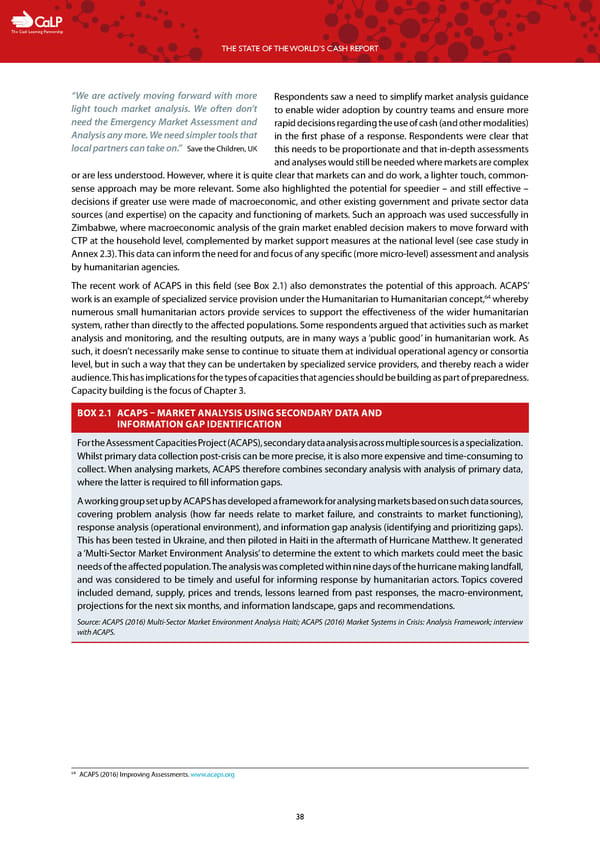C The Cash Learning Partnership THE STATE OF THE WORLD’S CASH REPORT “We are actively moving forward with more Respondents saw a need to simplify market analysis guidance light touch market analysis. We often don’t to enable wider adoption by country teams and ensure more need the Emergency Market Assessment and rapid decisions regarding the use of cash (and other modalities) Analysis any more. We need simpler tools that in the first phase of a response. Respondents were clear that local partners can take on.” Save the Children, UK this needs to be proportionate and that in-depth assessments and analyses would still be needed where markets are complex or are less understood. However, where it is quite clear that markets can and do work, a lighter touch, common- sense approach may be more relevant. Some also highlighted the potential for speedier – and still effective – decisions if greater use were made of macroeconomic, and other existing government and private sector data sources (and expertise) on the capacity and functioning of markets. Such an approach was used successfully in Zimbabwe, where macroeconomic analysis of the grain market enabled decision makers to move forward with CTP at the household level, complemented by market support measures at the national level (see case study in Annex 2.3). This data can inform the need for and focus of any specific (more micro-level) assessment and analysis by humanitarian agencies. The recent work of ACAPS in this field (see Box 2.1) also demonstrates the potential of this approach. ACAPS’ 64 work is an example of specialized service provision under the Humanitarian to Humanitarian concept, whereby numerous small humanitarian actors provide services to support the effectiveness of the wider humanitarian system, rather than directly to the affected populations. Some respondents argued that activities such as market analysis and monitoring, and the resulting outputs, are in many ways a ‘public good’ in humanitarian work. As such, it doesn’t necessarily make sense to continue to situate them at individual operational agency or consortia level, but in such a way that they can be undertaken by specialized service providers, and thereby reach a wider audience. This has implications for the types of capacities that agencies should be building as part of preparedness. Capacity building is the focus of Chapter 3. BOX 2.1 ACAPS – MARKET ANALYSIS USING SECONDARY DATA AND INFORMATION GAP IDENTIFICATION For the Assessment Capacities Project (ACAPS), secondary data analysis across multiple sources is a specialization. Whilst primary data collection post-crisis can be more precise, it is also more expensive and time-consuming to collect. When analysing markets, ACAPS therefore combines secondary analysis with analysis of primary data, where the latter is required to fill information gaps. A working group set up by ACAPS has developed a framework for analysing markets based on such data sources, covering problem analysis (how far needs relate to market failure, and constraints to market functioning), response analysis (operational environment), and information gap analysis (identifying and prioritizing gaps). This has been tested in Ukraine, and then piloted in Haiti in the aftermath of Hurricane Matthew. It generated a ‘Multi-Sector Market Environment Analysis’ to determine the extent to which markets could meet the basic needs of the affected population. The analysis was completed within nine days of the hurricane making landfall, and was considered to be timely and useful for informing response by humanitarian actors. Topics covered included demand, supply, prices and trends, lessons learned from past responses, the macro-environment, projections for the next six months, and information landscape, gaps and recommendations. Source: ACAPS (2016) Multi-Sector Market Environment Analysis Haiti; ACAPS (2016) Market Systems in Crisis: Analysis Framework; interview with ACAPS. 64 ACAPS (2016) Improving Assessments. www.acaps.org 38
 The State of the World's Cash | Full Report Page 39 Page 41
The State of the World's Cash | Full Report Page 39 Page 41